

Performances & Polar Fair
Performances & Polar Fair
2007 New York City International Polar Weekend offered the following special performances:
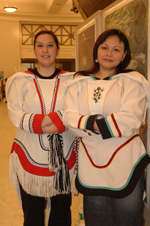 |
Inuit Cultural Performers: Throat Singers performance by Canadian Inuit Performers The Inuit Cultural Performers are a group of young Inuit from Ottawa, Canada involved in promoting and preserving the Inuit culture through performing traditional cultural presentations. Throat singing is a unique type of vocalization generally involving two people who face each other and throat sing songs that imitate sounds found in nature such as: seagulls, geese, the wind, running water. Marine Mammals: Penguins and Polar Bears performed by the Central Park/Bronx Zoo The Central Park Zoo 'Wildlife Theater' provided a family show about two favorite polar opposites - penguins and polar bears! In "The Polar Bear and the Beat" the audience actively participated as Polar Bear searched for his lost rhythm of life and learns that the smallest things are sometimes the most important. In "Petunia Penguin" a chilly polar expedition is turned into an exciting learning event about sharing facts about the adaptation penguins use to survive the harsh environment they call home. |
|---|
Polar Fair series of interactive exhibits: Designed for family involvement…lots of hands on activities, scientists and equipment, polar gear and clothing. A great way to joinin the exploration of ‘the polar regions’! To view posters for a sample of the exhibits click on the underlined titles.
Extreme Environments - Deep ice life? Lake Vostok With Michael Studinger, LDEO and Nick Frearson, British Antarctic Survey
Astrobiology Polar Exploration as a model for Mars, Moon, Europa Exploration; With Laura Kay, Barnard
The extreme temperatures and environments of the poles encourage scientists to study these areas as a proxy for lifeand environments on other planets.
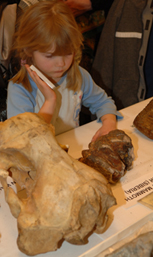 |
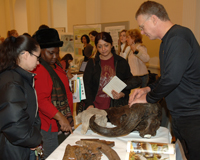 |
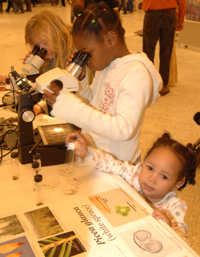 |
|---|
Reconstructing the Past -Arctic Dinosaurs and New York Walrus: With Ross MacPhee, AMNH
What clues to the past lie in understanding the Ellesmere dinosaur; Spitsbergen and Antarctic ferns and ginko leaves; New York Harbor mastodon teeth and walrus; New Jersey mammoth
Polar Landscapes in New York at the close of the Ice Age: With D. Peteet, NASA/GISS/LDEO M. Jones, LDEO; S. Sritrairat, LDEO, M. Beh, LDEO; Calder Orr, LDEO
What was New York like at the close of the last ice age? What plants and animals were present near the ice margin? What was the climate like as the ice melted, and when did it melt? New data from the base of many wetlands (lakes, ponds, fens, bogs, swamps) in the New York-New Jersey-Connecticut-Penn. region have been investigated to answer these questions. Almost all of our data shows the ice lasted until about 15,500 years ago, when the area was an arctic-subarctic environment.
Polar Artists & Writers - Imagining and depicting the poles through the centuries; artistic representation of the effect of global warming on Arctic ice - Warning Signs by Susan Muñoz and Irena Gorodetskaya, LDEO
A collaborative photographic work between American artist, Susan Muñoz, whose work deals with pattern formation in nature, and Russian scientist, Irina Gorodetskaya, who studies the impact of the reflective nature of ice, known as albedo, on global climate change. The piece is called “Warning Signs.” A grid of 9 mounted photographs show the process of melting that occurs in the Arctic ice pack. The images tell the story of the demise of the perfect white reflective surfaces that have comprised the Arctic ground cover for thousands of years, moving from ice to snow to slush to the formation of melt ponds and finally giving way to black ocean. It is a progression from purity to disintegration, an apt metaphor for what we are doing to our earth as we accelerate the process with human waste products. Like street signs, they are intended to convey a message that captures the viewer’s attention.
Polar poems With Susan Fox-Rogers, Bard
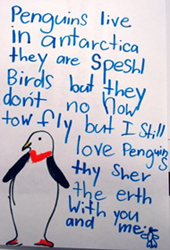 |
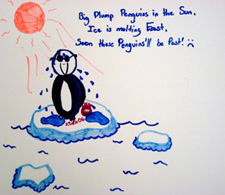 |
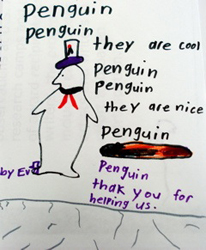 |
|---|
Participants create “found poems” describing their imagined journey to the poles. Gathering images, language and information from the various exhibits, writers young and old crafted poems filled with penguins, polar bears or the light and silence of a glacier.
Polar Gear - What is it like to work in the poles? With Adrienne Smith, LDEO; Gear Provided by CRREL
What is with all those layers of clothes? How do you do science in all that clothing? See some of the science equipment used in polar research. Photo-ops: try on clothing.
IGY field work - sampling in and under ice With Ken Hunkins and Chuck Hubbard, LDEO
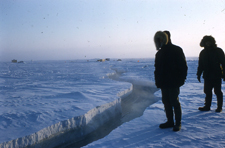 |
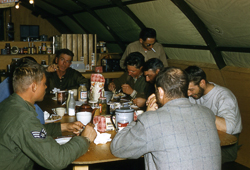 |
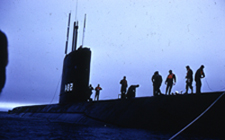 |
|---|
The Arctic Ocean is bordered by Europe, Siberia, Alaska, Canada and Greenland A canopy of drifting sea ice covers the deep basin which has depths exceeding 4000 meters. The sea ice cover moves several miles a day under the influence of wind and current. As it moves it fractures into ice floes bordered by freezing leads of open water and ridges of jumbled ice blocks. Exploration is carried out under difficult conditions of cold temperatures and the rough dynamic surface. One of the most effective platforms for investigating the Arctic Ocean has been manned camps on drifting ice floes established and supported by aircraft. During the International Year (1957-8) ice station ALPHA served as a platform for scientific studies of the arctic environment. Ken Hunkins served at this station and provided the above photographs of this event.
Polar Ice - Polar Warming and Melting With David Holland, NYU
What do we know about sea-level change? What do we know is changing? What don’t we know? And what are we doing?
Life in the Icy Waters With Andy Juhl, LDEO and Ray Sambratto, LDEO The polar waters are home to some of our largest mammals – but what do they find to eat in these forbidding regions? Explore life through the primary producers. Penguins and Polar Bears and the tip of the Iceberg With the Central Park and Bronx Zoo Join the staff from the zoo for some exciting activities and games to learn all about life at the two poles. What Motivates Exploration - With Debika Shome, CRED Columbia |
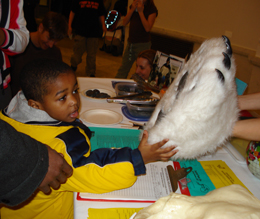 |
|---|
New York in Polar History With Milbry Polk, Wings World Quest
Many of the early explorers and participants in the early exploration and science of the poles , including the first IPY & IGY, were from the New York area and were members in the Explorers Club. Women explorers also were prominent in New York history.
Inuit and Viking History With Tom McGovern, Hunter; Sophia Perdikaris, Brooklyn, CUNY
Explore the Inuit perspectives, early anthropology, Norse history…what are some of the human influences on the environment and climate.
Kayaks and the Arctic
Historically kayaks played a large role in Arctic transport and movement. How did kayaking develop in the Arctic? What is an Anorak? How does a Greenlandic paddle differ from the paddles you see uned in the New York area?
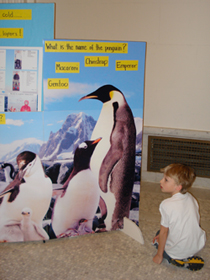 |
Teachers on Ice With Lisbeth Uribe, The School at Columbia; Vanessa Miller, Central Park East II Two New York City teachers who have traveled to the Antarctic – see what they wore, what they learned. How do you stack up to the size of a penguin? How does a penguin stay warm? What can you learn from an ice core? What does ANDRILL mean? The Poles and the Sun With AMNH What is it like to live and work near the poles? Day or Night? How can we tell? The History of IPY AND Science plans for IPY 2007-2009With Barnard College Students What is the International Polar Year (IPY)? How many have there been before? What have we learned from prior IPY’s? What is happening this IPY? |
|---|